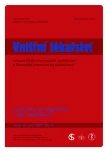Pancreaticopleural fistula
Authors:
P. Jakubec 1; V. Kolek 1; V. Procházka 2; M. Konečný 2; T. Jakubcová 1
Authors‘ workplace:
Klinika plicních nemocí a tuberkulózy Lékařské fakulty UP a FN Olomouc, přednosta prof. MUDr. Vítězslav Kolek, CSc.
1; II. interní klinika Lékařské fakulty UP a FN Olomouc, přednosta doc. MUDr. Vlastimil Procházka, Ph. D.
2
Published in:
Vnitř Lék 2007; 53(2): 135-142
Category:
Original Contributions
Overview
Pancreatic diseases are often accompanied by pleuropulmonal complications. Acute pancreatitis may induce a number of various pathological findings in respiratory tract including hypoxemia, decrease of transfer-factor (DLCO), decrease of transfer-coefficient (DLCO/VO), decrease in forced expiratory flow 25 %– 75 % of forced vital capacity (FEF25–75 %), elevated and/o immobile diaphragm, basal atelectasis, unilateral or bilateral pulmonary infiltrations, mediastinal pseudocyst and pleural effusion. Acute respiratory distress syndrome (ARDS) is the most dangerous complication of acute pancreatitis. Large, recurrent pleural effusion is sometimes present in chronic pancreatitis, typically with a very high concentration of amylase in pleural fluid. Pancreaticopleural fistula (PPF) is the most common cause of this type of pleural effusion. We describe a study group of 3 patients with PPF and pleural effusion, their clinical symptoms, diagnostics and management.
Key words:
acute pancreatitis – chronic pancreatitis – pleural effusion – pancreaticopleural fistula
Labels
Diabetology Endocrinology Internal medicineArticle was published in
Internal Medicine

2007 Issue 2
Most read in this issue
- Fever of unknown origin – etiology and diagnostic algorithm
- Czech Atherosclerosis Society Guidelines for the Diagnosis and Treatment of Dyslipidemias in Adults
- Long term effectiveness of surgical cryoMAZE ablation for chronic atrial fibrillation in patients undergoing surgery for severe mitral valve regurgitation
- Encapsulating peritoneal sclerosis
